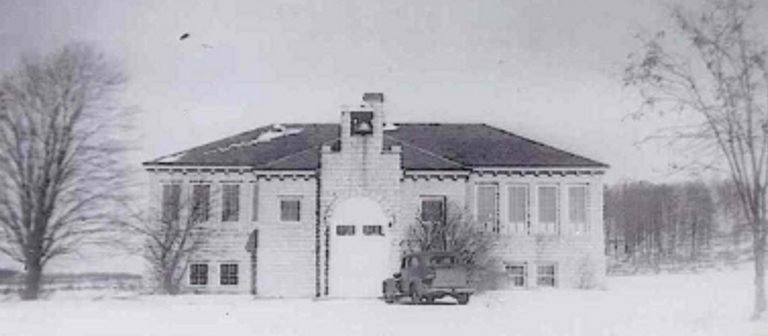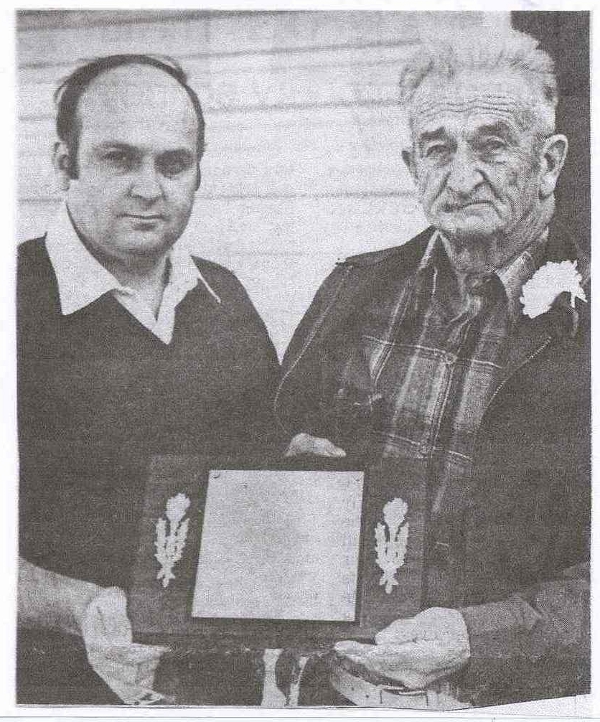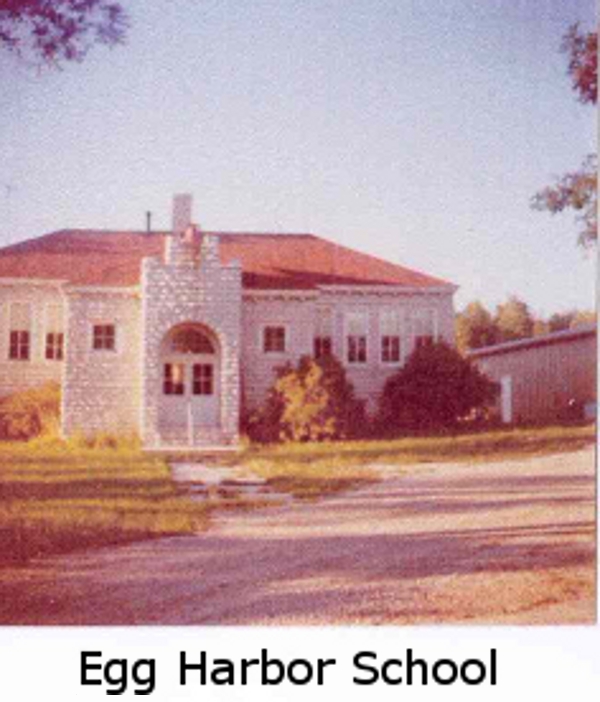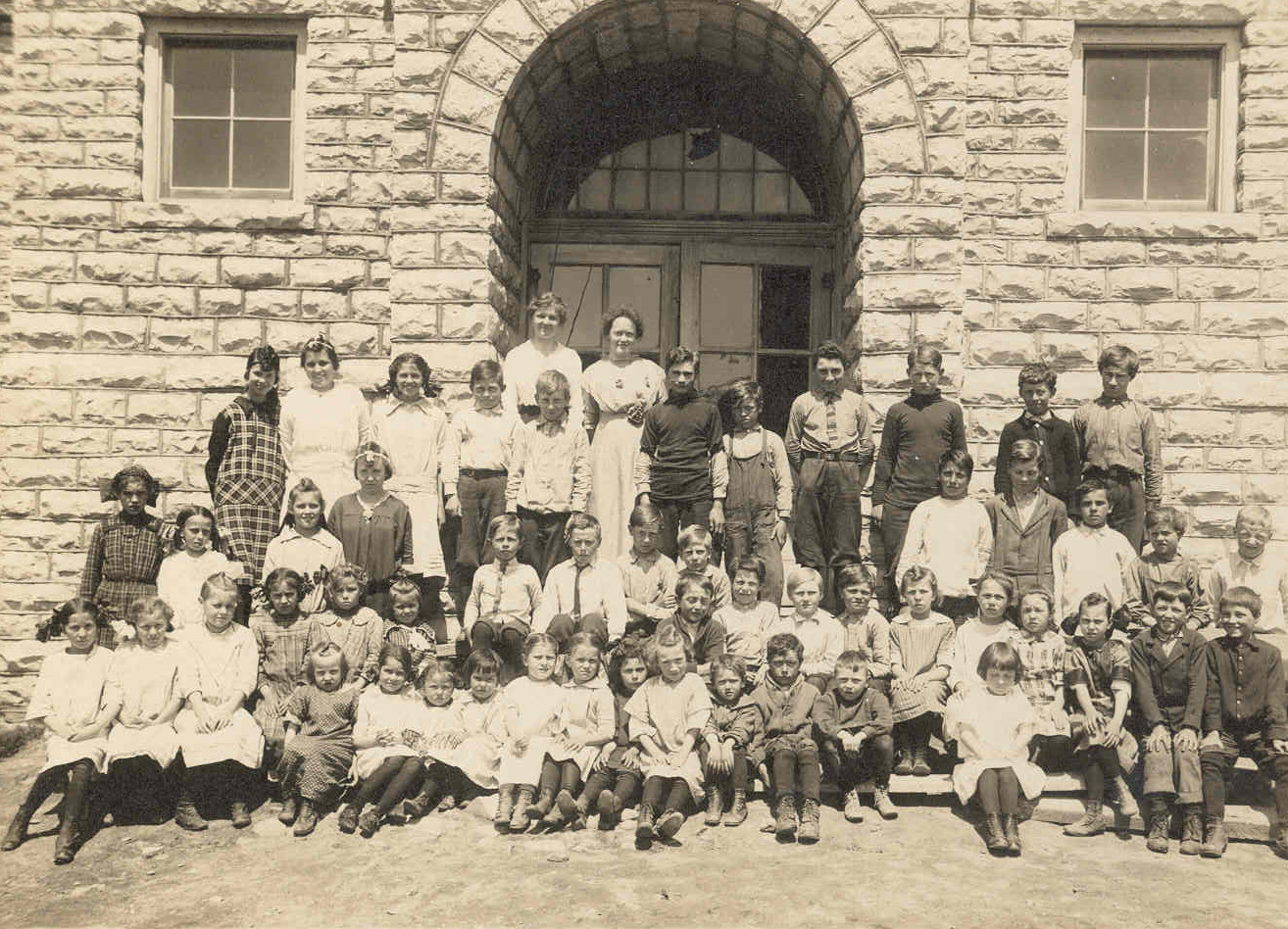Note: The Historical Society extends a very sincere thank you to Patty Williamson for taking the time to write up this great piece on our reunion!
By Patty Williamson, PhD
No school bell rang to call them. In fact, the school where the bell once hung was razed 39 years ago. But the memories are still strong, and on a summer Sunday morning, 147 people with ties to Egg Harbor School District No. 1 came together on the spot where the elementary school once stood on what is now Harbor School Road.
The reunion, organized by the Egg Harbor Historical Society, was the first reunion – but also the 60th – celebrating the school’s 60 years of operation, 1912 to 1972.
The event was held on the grounds of the Egg Harbor Fire Department, near the school site. The cover of the reunion program featured a painting of the school by local artist Giz Herbst.
On July 10, 1910, Egg Harbor voters approved a loan of $2,500 from the state to build a school that would be constructed of stone similar to their new Catholic church. When it opened in 1912, it was described as one of the best schools in the county in terms of architecture and equipment. It was expected to qualify for $200 a year in state aid. A third classroom was created in the remodeled basement in 1965. The school was closed in 1972, with children then assigned to the Gibraltar or Sevastopol districts. The building was torn down in 1977, after the village decided it would be too expensive to rehab it for a village hall.
The Egg Harbor Braves still use the old school ball field, with bleachers and a concession stand, for their Northern Door Little League games.
Jim Petersen, president of the Egg Harbor Historical Society, emceed the celebration. A highlight was the dedication of a plaque recognizing Egg Harbor’s three elementary schools. The first Egg Harbor School, a wooden building on Horseshoe Bay Road, just south of the present-day Harbor View Park, operated from 1876 until 1912. The second was Pleasant Grove District School No. 5, built in 1895 just a mile east of District No. 1 on School Road. It closed in 1947. The third, of course, was Egg Harbor School District No. 1, the school being celebrated at the reunion. All alumni at the event received copies of the two-book set, Celebrating Egg Harbor 1861-2011, compiled by the historical society in 2011.

The Egg Harbor School in the 1940s.
The oldest attendee at the reunion was Eva Jorns Petermann, 94, followed by Bill Bertschinger, Margaret Polcin Franke and Roland Jorns, also born in the 1920s. Penny Demmin Tayara of Temula, CA, traveled the farthest to the reunion, 1,776.49 air miles. Others who came a long distance were: Mary Haen Lautenbach, Surprize, AZ; Paul Lautenbach, Sun City, FL; Barb Herbst Kramer, Albuquerque, NM; and Joanne Perry Cox, Tallahassee, FL.
Three families included two generations who had attended Egg Harbor School: Eva Petermann Jorns and Pam Vrooman McNamara; Roland Jorns and Steve Jorns; and Ruby Volkmann Demmin and Mary Demmin, Penny DemminTayara and John Demmin, Teachers Eunice Rutherford, 1967-1971, and Glenn Gerdman, 1969-70, also attended.
The school had 53 teachers during its 60 years of existence. In the first 32 years, many left after one term, probably because until 1944 women had to resign when they married. Lloyd Perry had the longest tenure – 1938 to 1962. His daughter, Beverly Perry Hogan, recalls that for all those years her father got to school at 6 am, fired the stoker for the furnace, wrote his lessons on the blackboard and stayed until 6 pm, doing the janitorial work with the help of his wife, Nora. Lloyd also arranged for PTA meetings, sponsored a Boy Scout troop and a 4-H club and coached sports.

Former teacher Lloyd Perry honored with a plaque recognizing his decades of service at the Egg Harbor School.
Virginia Paul Martin, who taught grades 1-4 in 1952-54, reported that one hour each month she took the girls in grades 5-8 into her room and taught them hand stitchery and simple cookery, while Mr. Perry taught the boys in those grades simple carpentry.
Gibraltar teachers Rod Billerbeck and Frank Summerfeldt came to the school once a week to offer physical education and music classes, respectively.
Mildred Leimbach prepared hot lunches for 40 students on a wood cook stove. Food was purchased from Trodahl’s Grocery, and she made 15 loaves of bread a week, started at home and baked at school.
A number of the alumni shared their memories. Arlene Gerlach Hovel of Lodi, WI, attended the school for all eight grades, graduating in 1963. She loved the playground by the big maple tree, especially the teeter-totter, huge slide and merry-go-round. She remembers getting stage fright and forgetting her lines in every Christmas program, but loved participating, anyway. A favorite memory is when the Ames Orchard wagons full of apples would pass the school. All the students would run to the road and say, “Throw us an apple,” and the driver would wait until every child got one. She loved the mac and cheese (and seconds, if there was some left) and recalls running to the grocery after lunch to buy a bag of candy for a quarter.
She especially loved the “wonderful sound of the school bell,” purchased by ladies in the town in 1921.

Egg Harbor School in the early 1970s, not long before it was razed.
Robert Sauger of Sheboygan helped his mother farm 200 acres, but after her death when he was 14, he lived with the Charles Martens family. He says that playing ball at recess was a paramount thing in students’ lives. He enjoyed coming to school, walking the mile and a quarter in bad weather, when the roads were too bad to ride his bike. Swimming from the Egg Harbor and Alpine Beach docks was a big thing in summer.
John Toppe’s favorite memory from first grade is running down the road to meet his teacher, Eleanor Kwaterski, so he could hold her hand the rest of the way to school.
(There was great competition for this privilege among the little boys.) There were three boys in his class and two or three girls. Another memory from first grade was an all-school softball game against Baileys Harbor. John was so excited to play with the big kids, especially the star player, eighth-grader Clayton Moegenburg. But just when it was John’s time to bat, the game ended. (He’s remembered that disappointment for 70 years!) Drinking water came from a faucet on a barrel. Kerosene came from a similar barrel, and one day John mistakenly drank from the wrong faucet. He grew up to teach physical education and coach for 25 years in Sturgeon Bay.
Mary Lautenbach Martin’s best memory is the Spanish rice made by cook Freida LaPlant. Mary checked with her sister, Jane, to make sure she had the ingredients right: hamburger, white rice, sweet corn, carrots, celery and mustard sauce.

Children in front of the Egg Harbor School, circa 1920.
Judi Haen Dexheimer, a member of the Egg Harbor Historical Society Board who played a major role in organizing the reunion, says it was difficult to contact people, because class lists were lost when the county superintendent’s office closed and so many people no longer have listed phones. She loved the merry-go-round on the playground, playing jacks and tackle football with the boys. She says Lloyd Perry was the best teacher ever, making sure that everyone learned. Like many others, Judi mentioned that highlights were the Christmas programs and the wonderful end-of-school picnics. Her favorite task was clapping the erasers at the end of the day. After fifth grade, she was the only girl in her class. She walked to school on a trail by Lena’s old tavern, one of five in Egg Harbor at that time, along with the Lull-Abi and Cape Cod motels, three groceries, three gas stations and a post office.
Barb Herbst Kramer and Mary Lautenbach Martin have been best friends since age five. They went to school together from first grade through UW-Madison. Now living in Albuquerque and Wisconsin Rapids, respectively, they still talk on the phone at least once every day and sometimes more often.
Steve Jorns, of Jorns’ Sugar Bush, had an adventure as a first grader in 1959. The teacher was late in arriving the morning after a blizzard, and children waiting for her were freezing. Steve, a little fellow, volunteered to slide down the coal chute to the basement. He climbed out of the coal bin and ran to the door just as the teacher unlocked it. “She had to be stern with me,” he says, “but she chuckled every time she looked at me, covered with coal dust from head to toe!” He remembers the game of work-up baseball that lasted from the first day of school until it snowed, and the big merry-go-round that went round and round, in and out, jerky-jerk. Like many others, he was happy to see that the big maple tree that shaded their playground is still standing, although the limb that held the swing is missing.
Steve has great respect for the fact that the cook, Eva Jane Erskine, taught the students responsibility. “Everyone had a job,” Steve says. “The older kids served and cleaned up the lunchroom, little ones watered the plants and cleaned erasers. The older boys shoveled coal. No one left until all the jobs were done.” Mrs. Erskine was deaf, and students had to face her when speaking. “She told me she was going to make me a good husband,” Steve recalls.